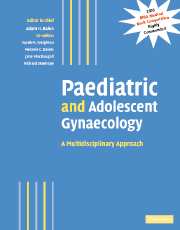Book contents
- Frontmatter
- Contents
- Contributors
- Preface
- Part I Normal development
- Part II Management of developmental abnormalities of the genital tract
- Part III Management of specific disorders
- 18 Disorders of growth and puberty
- 19 Turner's syndrome
- 20 Androgen insensitivity syndromes
- 21 Rokitansky syndrome and other Müllerian anomalies
- 22 The XY female
- 23 The gynaecology of the major genitourinary anomalies
- 24 Congenital adrenal hyperplasia
- 25 Long-term sequelae of genital surgery
- 26 Amenorrhoea
- 27 The polycystic ovary syndrome and adolescent women
- 28 Menstrual disorders in adolescent girls
- 29 Pelvic pain, ovarian cysts and endometriosis in adolescent girls
- 30 Premature ovarian failure and ovarian ageing
- 31 Gynaecological cancers in childhood
- 32 Late reproductive sequelae of treatment for childhood cancer
- 33 Preservation of fertility before cancer therapy
- 34 The management of infertility with surrogacy and egg donation
- 35 Dermatological conditions of the female genitalia
- 36 Vaginal discharge
- 37 Psychological gender development in individuals born with ambiguous genitalia
- 38 Eating disorders in adolescence
- 39 Nutritional amenorrhoea: long-term sequelae
- 40 How to set up a service: how to teach and train
- Index
- Plate section
- References
19 - Turner's syndrome
from Part III - Management of specific disorders
Published online by Cambridge University Press: 04 May 2010
- Frontmatter
- Contents
- Contributors
- Preface
- Part I Normal development
- Part II Management of developmental abnormalities of the genital tract
- Part III Management of specific disorders
- 18 Disorders of growth and puberty
- 19 Turner's syndrome
- 20 Androgen insensitivity syndromes
- 21 Rokitansky syndrome and other Müllerian anomalies
- 22 The XY female
- 23 The gynaecology of the major genitourinary anomalies
- 24 Congenital adrenal hyperplasia
- 25 Long-term sequelae of genital surgery
- 26 Amenorrhoea
- 27 The polycystic ovary syndrome and adolescent women
- 28 Menstrual disorders in adolescent girls
- 29 Pelvic pain, ovarian cysts and endometriosis in adolescent girls
- 30 Premature ovarian failure and ovarian ageing
- 31 Gynaecological cancers in childhood
- 32 Late reproductive sequelae of treatment for childhood cancer
- 33 Preservation of fertility before cancer therapy
- 34 The management of infertility with surrogacy and egg donation
- 35 Dermatological conditions of the female genitalia
- 36 Vaginal discharge
- 37 Psychological gender development in individuals born with ambiguous genitalia
- 38 Eating disorders in adolescence
- 39 Nutritional amenorrhoea: long-term sequelae
- 40 How to set up a service: how to teach and train
- Index
- Plate section
- References
Summary
Introduction
Turner's syndrome (TS) is the most common sex chromosome disorder among women, affecting 1 out of 2000 liveborn girls (Gravholt et al., 1996). The main characteristics of TS include short stature and failure to enter puberty; this resuts from an accelerated rate of atresia of ovarian follicles, causing gonadal insufficiency and infertility. There is also a wide range of additional morbidities associated with the syndrome, as many other organ systems and tissues may be affected to a lesser or greater extent. Therefore, the variability of amount and degree of medical and psychosocial problems between individuals is great and the effects on health and quality of life vary from slight to profound. The need for hormone replacement therapy (HRT) to promote growth and puberty gives the paediatric endocrinologist the most central role when caring for and treating girls with TS. Among women of adult age with TS, counselling on fertility problems puts the focus on the specialists in reproductive medicine and clinical genetics, who are important members of a multidisciplinary network of different specialists in the counselling team.
Genetics
TS is a combination of clinical features caused by complete or partial loss of the second sex chromosome, with or without cell line mosaicism. It is believed that over 50% of the women with TS have a complete loss of one X chromosome (i.e. monosomy 45,X), while 20% have one normal X chromosome together with a structurally altered X chromosome.
- Type
- Chapter
- Information
- Paediatric and Adolescent GynaecologyA Multidisciplinary Approach, pp. 242 - 252Publisher: Cambridge University PressPrint publication year: 2004
References
- 1
- Cited by



